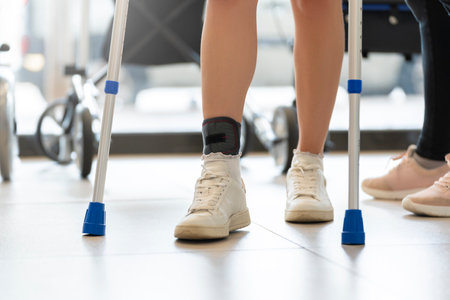Introduction to Taping Methods in UK Healthcare
Taping techniques have become an integral part of injury management and rehabilitation across the UK, both within clinical settings and on the sports field. In British physiotherapy clinics, musculoskeletal practices, and athletic environments, two primary taping approaches are widely employed: kinesiology taping and rigid sports taping. Each method serves specific purposes, from providing structural support to aiding recovery and enhancing proprioception. Kinesiology tape, known for its elastic properties and colourful appearance, has gained popularity in recent years due to its perceived benefits in facilitating movement and reducing discomfort. In contrast, rigid sports tape has long been a staple in UK sport, valued for its ability to restrict joint motion and offer robust support during high-impact activities. Both approaches are well-established within British healthcare protocols and are frequently observed in NHS physiotherapy departments, private practices, and pitch-side care at sporting events across the country. The following discussion will explore how these taping methods are applied in UK clinical contexts, their acceptance among practitioners, and considerations for choosing between them based on current best practice.
2. Fundamentals of Kinesiology Taping
Kinesiology taping has gained significant traction in UK clinical settings, particularly within physiotherapy and sports rehabilitation environments. This taping method is distinct from traditional rigid sports taping due to its elastic properties and purported neuromuscular effects. At its core, kinesiology taping is rooted in the principle of facilitating the bodys natural healing processes while providing support and stability to muscles and joints without restricting the range of motion.
Theoretical Underpinnings
Developed originally in Japan, kinesiology taping operates on the theory that elasticity in the tape can lift the skin microscopically. This action is thought to create more space for lymphatic fluid movement, thus reducing inflammation and supporting circulation. In UK practice, clinicians often cite these mechanisms when justifying its use for conditions such as muscle strains, joint pain, and postural correction.
Materials Used in Kinesiology Taping
Kinesiology tape differs markedly from rigid tapes both in composition and feel. The materials are hypoallergenic, breathable cotton with acrylic adhesive, designed to mimic the stretch characteristics of human skin. The following table summarises key material differences relevant to UK practitioners:
| Feature | Kinesiology Tape | Rigid Sports Tape |
|---|---|---|
| Elasticity | Up to 140-180% | Minimal/None |
| Material | Breatheable cotton, acrylic glue | Zinc oxide cloth or synthetic |
| Water Resistance | High (can be worn for days) | Moderate (typically single-use) |
Typical Applications by UK Practitioners
Kinesiology tape is commonly applied by physiotherapists, osteopaths, and sports therapists across the UK. Its versatility means it is used for a variety of musculoskeletal complaints, including:
- Supporting injured muscles without limiting movement (e.g., hamstring strains in footballers)
- Pain management through proprioceptive feedback (common in NHS outpatient clinics)
- Lymphatic drainage after acute injuries (notably among rugby players and runners)
Clinical Integration in the UK Context
It is worth noting that UK clinicians often integrate kinesiology taping with other evidence-based interventions, such as manual therapy or exercise prescription. While robust clinical evidence remains under discussion within NHS guidelines, anecdotal reports from practitioners highlight improved patient compliance and satisfaction due to the non-restrictive nature of kinesiology tape compared with rigid options.

3. Principles and Practice of Rigid Sports Taping
Rigid sports taping, sometimes referred to as athletic taping or zinc oxide taping in the UK, is a longstanding technique in British clinical and sporting environments. Unlike kinesiology tape, which is elastic and designed for dynamic support, rigid tape offers minimal stretch and is primarily used to restrict movement at joints or stabilise injured structures. The principle behind its application is straightforward: by limiting excessive or harmful movement, clinicians can reduce pain, prevent further injury, and support rehabilitation.
Traditionally, rigid sports taping has been most prevalent in high-contact or team sports such as rugby union, football, and netball across the UK. It is routinely employed in pitch-side settings as well as physiotherapy clinics to provide immediate stability following acute injuries—such as ankle sprains, ligament tears, or dislocations. In these scenarios, the mechanical support offered by non-elastic tape can be crucial for both protection and confidence during return-to-play protocols.
UK clinicians tend to use rigid tape for preventative taping routines too. For example, athletes with a history of ankle instability may have their joints taped before matches or training sessions to minimise the risk of recurrence. The technique requires precise knowledge of joint anatomy and biomechanics; improper application can result in discomfort or even circulatory issues. Therefore, practitioners receive formal training—often through accredited courses regulated by bodies such as the Chartered Society of Physiotherapy (CSP) or the Health and Care Professions Council (HCPC).
While the robust nature of rigid taping makes it highly effective for immobilisation, it does come with certain trade-offs. The lack of flexibility means that it is not suitable for every clinical presentation—especially where maintaining a degree of functional movement is important. In addition, rigid tapes can cause skin irritation if worn for extended periods or applied incorrectly. As a result, UK clinicians carefully assess each case before deciding on this intervention, often balancing the need for stability against patient comfort and long-term recovery goals.
4. Comparative Clinical Effectiveness
The comparative clinical effectiveness of kinesiology taping (KT) and rigid sports taping (RST) has become a focal point in UK physiotherapy and sports medicine. Drawing on both published research and practical observations from NHS trusts and private clinics, this section critically summarises current evidence regarding the efficacy of these two taping modalities.
Evidence from UK Clinical Studies
Recent systematic reviews and UK-based randomised controlled trials (RCTs) provide mixed results. Kinesiology taping is often valued for its flexibility, proprioceptive feedback, and patient comfort. Conversely, rigid sports taping is widely recognised for providing firm support to joints and restricting unwanted movement, which is particularly beneficial in acute injury management.
| Taping Modality | Primary Indications | Reported Effectiveness (UK context) |
|---|---|---|
| Kinesiology Taping | Muscle facilitation, oedema reduction, proprioceptive enhancement | Moderate evidence for short-term pain relief and improved range of motion; inconsistent findings for long-term outcomes |
| Rigid Sports Taping | Joint stabilisation, ligament injury support, preventative strapping | Strong evidence for acute joint stability; limited benefit for muscle injuries or chronic conditions |
Observations from UK Practitioners
Anecdotal reports from UK clinicians highlight that patient preference often plays a significant role in modality selection. For example, football clubs in the English Premier League tend to favour rigid tape for ankle sprains during matches, prioritising stability. In contrast, community physiotherapy services may lean towards kinesiology tape for longer-term musculoskeletal conditions due to its comfort and lower risk of skin irritation.
Critical Appraisal of Efficacy
The majority of practitioners agree that neither taping method should be used as a standalone treatment. Instead, both are most effective when integrated into comprehensive rehabilitation programmes. The decision between KT and RST frequently hinges on individual clinical goals—whether immediate immobilisation or facilitating functional movement is required.
Summary Table: Pros and Cons in UK Clinical Practice
| Taping Type | Pros | Cons |
|---|---|---|
| Kinesiology Tape | Comfortable Promotes natural movement Good patient compliance |
Less support for unstable joints Varied clinical outcomes Limited effect in acute injuries |
| Rigid Sports Tape | Excellent joint stability Reliable in acute settings Widely understood application techniques |
Can restrict circulation if misapplied Potential for skin issues Reduced comfort during prolonged wear |
This critical review underscores the importance of context-specific application and individual assessment in determining optimal taping strategies within UK clinical settings.
5. Considerations for Patient Care in British Contexts
When comparing kinesiology taping and rigid sports taping within UK clinical settings, it is essential to recognise how patient demographics, preferences, and the structure of British healthcare influence taping choices. The NHS and private practices both serve a diverse population, with varying ages, activity levels, and health beliefs. For instance, older patients or those with sensitive skin may prefer kinesiology tape due to its flexibility and lower risk of irritation. Conversely, athletes or individuals engaged in contact sports might lean towards rigid taping for its superior stability. Socioeconomic factors also play a role; NHS clinics often operate under budget constraints, potentially favouring cost-effective solutions such as rigid tapes. Meanwhile, private physiotherapy clients may have greater access to premium options like branded kinesiology tapes.
Patient Preferences and Communication
British patients tend to value evidence-based practice and clear communication regarding treatment options. Clinicians must therefore tailor their recommendations by considering not only the physical condition but also the patient’s personal goals and lifestyle. Informed consent is vital, as some individuals may have prior experiences or cultural attitudes that shape their expectations around taping methods.
Healthcare System Structure
The organisation of the UK healthcare system further impacts clinical decisions. NHS guidelines emphasise interventions that are supported by robust evidence and deliver value for money. This can limit the widespread adoption of newer or more expensive taping products unless proven superior. In contrast, private sector clinicians may have greater flexibility to experiment with different techniques based on individual outcomes.
Practical Implications
Ultimately, effective taping in the British context requires balancing clinical evidence, patient-centred care, and resource management. By understanding local healthcare dynamics and engaging patients in shared decision-making, practitioners can select the most appropriate taping method—ensuring optimal support, comfort, and satisfaction across varied clinical environments.
6. Conclusions and Recommendations for UK Practitioners
Practical Guidance for Everyday Clinical Choices
In summary, both kinesiology taping and rigid sports taping hold valid places within UK clinical practice, but their applications differ according to patient needs, sporting context, and clinical objectives. Kinesiology tape excels in cases where soft tissue support, proprioceptive feedback, and dynamic movement are priorities—such as in rehabilitation or when treating minor musculoskeletal discomfort. Rigid sports taping, on the other hand, is best reserved for situations demanding strong joint stabilisation or restriction of unwanted movements, as seen in acute ligament injuries or when protecting vulnerable joints during high-impact activities.
Key Takeaways for British Clinicians
- Patient Assessment: Thoroughly assess each patients injury profile, activity level, and expectations before deciding on a taping method.
- Clinical Goals: Select kinesiology taping for enhancing functional mobility and promoting recovery; choose rigid tape for preventative bracing or post-injury stabilisation.
- Cultural Context: Consider patient familiarity and acceptance—UK patients involved in amateur sport may be more accustomed to rigid taping protocols, while others may prefer the comfort and flexibility of kinesiology tape.
- Training & Evidence: Stay abreast of emerging research relevant to UK populations and ensure you maintain practical skills through regular CPD and peer discussion.
Recommendations for Practice
British clinicians are encouraged to use a patient-centred approach: educate patients about the expected benefits and limitations of each technique, monitor skin integrity especially in damp or changeable British weather conditions, and adapt application strategies based on individual response. Collaboration with multidisciplinary teams—including physiotherapists, GPs, and coaches—can help optimise outcomes. Ultimately, an open-minded yet evidence-informed stance will serve clinicians well as taping technologies and protocols continue to evolve within the UK’s diverse clinical landscape.


